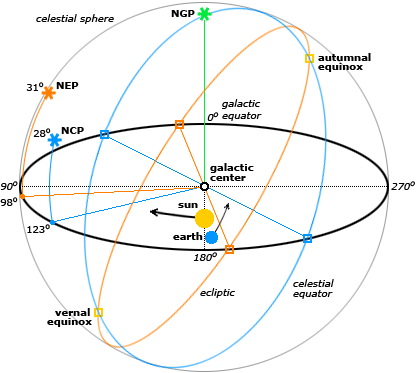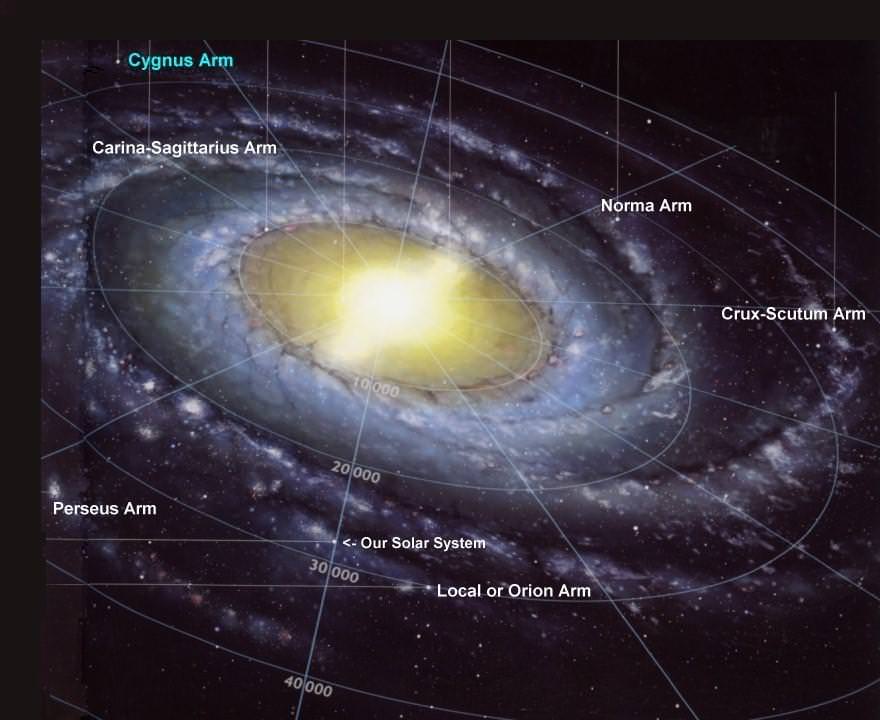You should always put out the old dinner set when you have astronomers around. It all starts innocently enough with imagine this wineglass is the Earth rotating on its axis… But then someone decides that large plate is just right to show the orientation of an orbital plane and more wine glasses are brought to bear to test a solution to the three body problem and…
My favorite dinner set demonstration is to use the whole table to represent the galactic plane – ideally with an upturned wide rimmed soup bowl in the middle to mimic the galactic hub. Then you get a plate to represent the solar system’s orbital plane and hold it roughly facing the galactic hub, but at a 63 degree angle from the horizontal. We know the equatorial plane of the Milky Way is tilted 63 degrees from the ecliptic – or vice versa since here we are arbitrarily making the galactic plane (table) the horizontal. This means galactic north is up towards the ceiling – and incidentally a line drawn north up from the galaxy’s centre (i.e. the galactic axis) passes fairly close to Arcturus.
Now for the Earth. Wine glasses make an excellent Earth model since the stem can represent the Earth’s axis of rotation. The glass is at least a bit round and you can see through it for a view of what someone would see from the surface of that glass.
Looking down on the solar system (plate) from its north, which is orientated away from the galactic hub (table), it actually rotates anti-clockwise. So if you hold the glass at the top of the plate – that’s Earth at about September, then move it to the left for December, down to the bottom for March, right side for June and back to September.
So, holding your plate at 63 degrees to the table, now hold the wine glass tilted at 23.5 degrees to the plate. Assuming you left your protractor at home – this will mean the wine glass stem is now almost parallel to the table – since 63 + 23.5 is close to 90 degrees. In other words, the Earth’s axis is almost perpendicular to the galactic axis.

You should really imagine the plate being embedded within the table, since you will always see some part of the Milky Way at night throughout the year. But, in any case, the wine glass gives a good demonstration of why we southerners get such a splendid view of the galactic hub in Sagittarius. It’s hidden in the daytime around March – but come September about 7pm you get the Milky Way running almost north-south across the sky with Sagittarius almost directly overhead. Arcturus is visible just above the western horizon, being about where the galaxy’s northern axis points (that is, the ceiling above the middle of the table).
And if you look to the north you can see Vega just above the horizon – which is more or less the direction the solar system (plate) is heading in its clockwise orbit around the galaxy (table).
Now, what’s really interesting is if I add the Moon in by just, oh… Er, sorry – that wasn’t new was it?


you can check out the 3D map of the Milky Way Galaxy at http://www.3dgalaxymap.com/Galaxy/
@ raydekk, a fascinating Milky Way SD representation of the Milky Way Galaxy. Quite cleverly done! I’ve bookmarked this site to return to further my knowledge concerning galactic encounters. Thanks for that link.
About the only feature I find missing in this 3D MW representation was of the X-shaped, peanut bulges in the inner halo along the barred portion of the inner galaxy, as has been demonstrated in other edge-on barred spiral galaxies. Other than that, a superb visualization of an SBbc galaxy.
Thank you! Concerning the “peanut bulges”, are you referring to the globular clusters? I’m not really sure I understand. I was thinking of adding them sometime in the near future but I haven’t seen any information about them (I’m mostly interested in the name and XYZ coordinates of each one). Adding random globular clusters doesn’t seem like such a good idea.
Also be sure to check out this paper about the 3D mapping of the Local Bubble and surroundings.
http://www.aanda.org/index.php?option=article&access=doi&doi=10.1051/0004-6361:20031214
@raydekk, Thanks for the reply! William Harris has a 2003 list of 150 Milky Way globular clusters that includes X, Y and Z coordinates here: http://seds.org/~spider/spider/MWGC/mwgc.html . A more complete 2007 list of globular clusters (sans XYZ co-ords) can be found here: (http) ://seds.org/~spider/spider/MWGC/mwgc.html.
Although I cannot find the precise paper, these “peanut, boxy, or cross-shaped” features (diffuse and stellar in origin) were discerned by careful analysis of WMAP data and were consistent with cusp orbits of old stars in the Milky Way bar and the bar’s nearly perpendicular orientation to the Earth. There was a WMAP illustration of this feature too. This paper appeared in 2010 or 2009.